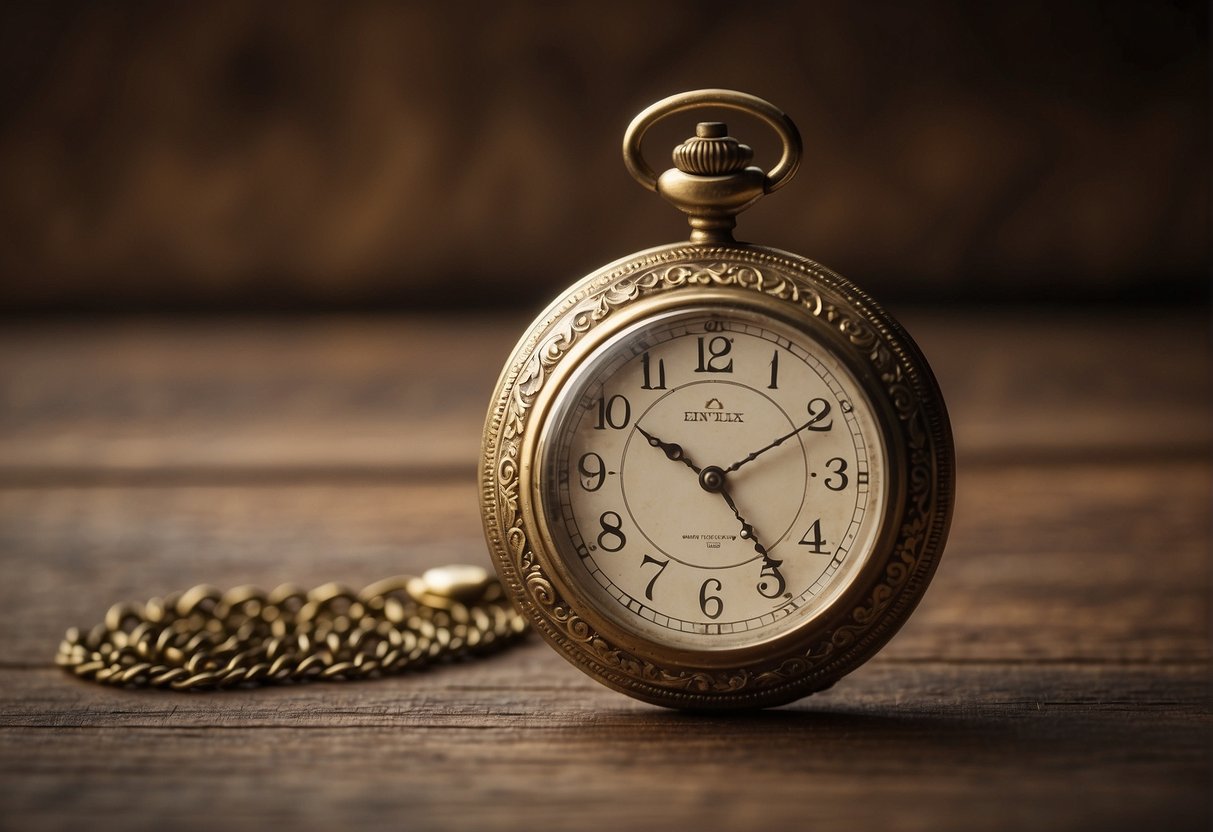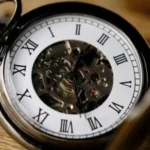Antique pocket watches are more than just timekeepers; they’re a glimpse into the artistry and engineering of the past. Setting the time on these elegant timepieces can seem daunting, but with the right approach, we can preserve their functionality and charm. Unlike modern watches, which often feature a simple crown that we pull and twist, an antique pocket watch may involve a few extra steps to properly set the time. After this guid you will never ask yourself the question “How to Set the Time on an Antique Pocket Watch?”
Understanding the various types of settings is crucial. Some antique pocket watches are pendant-set, requiring us to pull out the crown to set the time. Others might be lever-set, which involves opening the bezel and pulling out a small lever before we can adjust the time. The rarest are key-set watches, necessitating the use of a small key to wind and set the time. It is essential to identify the setting mechanism before attempting to adjust the watch to ensure we do not damage these delicate instruments.
Identifying Your Antique Pocket Watch
Before we dive into the specifics, it’s essential to recognize that deciphering the age, manufacturer, type, style, size, and mass of an antique pocket watch is critical to understanding its value and history.
Age and Manufacturer
To pinpoint the age of your pocket watch, take a close look at the serial number typically found on the watch’s movement. The manufacturer’s logo or insignia, often inscribed on the watch face or inside the case, is invaluable in determining the creator and consequently the era the watch is from. You can verify this information through online databases specializing in antique pocket watch identification.
Type and Style
Identifying the style of your pocket watch can significantly hint at its age and origin. Common types include:
- Open Face: No cover over the watch’s face, popular in the United States.
- Full Hunter: A solid outer cover that hinges open to reveal the dial.
- Demi-Hunter: Characterized by a window in the cover to glimpse the time.
- Sidewinder: The stem and crown are located at the 3 o’clock position.
- Trench Watch: Designed for military use, often has a rugged design and luminescent numerals for low-light reading.
- Waistcoat Style: A small, elegant watch typically attached to a waistcoat chain.
Size and Mass
The size of a pocket watch is generally denoted by the watch case‘s diameter, and sometimes the thickness is taken into account. It’s measured in ‘sizes’, where one size is approximately 1.8 centimeters. Mass can differ vastly, from light, delicate pieces favored in times of peace to the bulkier, more rugged watches like the trench watch designed for durability in war conditions. Knowing the size and mass provides clues to its use; for example, a heavy watch with a robust case might have been designed for outdoor activities, while a lighter and smaller watch could have been crafted for formal occasions to be worn with a waistcoat.
Preparing to Set the Time
Setting an antique pocket watch correctly is crucial to ensure its accuracy and longevity. We need to understand the watch movement and ensure that the winding process is done meticulously.
Understanding Watch Movement
Antique pocket watches typically feature mechanical movements, which require a manual winding process. The winding crown, also known as the winding arbor, is a knob located at the top of the watch, above the number 12. When setting the time, it’s imperative to handle the crown with care to avoid damage to the watch movement. For some watches, a lever must be pulled out to set the time, while others may use a different mechanism.
Winding Your Pocket Watch
Before we set the time, it’s essential to wind our pocket watch properly. This involves turning the winding crownclockwise to energize the watch’s internal winding mechanism. It’s recommended to wind the watch until there’s slight resistance, indicating the mainspring is fully wound. Avoid over-winding, as it could harm the watch’s delicate winding mechanism.
For a smooth and accurate time-setting experience, ensure the crystal—the glass covering the face of the watch—is free from obstructions, and use gentle but firm motions when handling the crown.
Setting the Time on Different Pocket Watch Types
Each time-setting mechanisms requires a specific approach to properly set the time.
Key Set Watches
Key-set watches require the use of a small key to set the time. To begin:
- Locate the setting mode: Insert the key into the keyhole located on the watch’s face or at the back.
- Engage the setting: Gently turn the key to move the hands to the correct time.
These watches are often wound using the same key, but in a different position or keyhole.
Lever Set Watches
Lever-set watches feature a small lever that must be engaged to set the time:
- Access the lever: Open the bezel or case back to reveal the lever.
- Set the time: Pull out the lever gently and turn the crown to set the time, then push the lever back in and close the watch case.
Lever set was a common safety feature to prevent accidental time changes.
Pendant Set Watches
Pendant-set watches rely on the crown:
- Engage the setting mode: Pull out the crown, located at the top of the watch above the number 12.
- Set the time: Turn the crown to adjust the hands, then press it back in to resume the movement.
This is the method most modern watches use and is named for the pendant-like appearance of the crown.
Caring for Your Antique Pocket Watch

Caring for Your Antique Pocket Watch is about honoring their craftsmanship and ensuring that these classic timepieces can continue to be treasured for years to come.
Regular Maintenance
Our antique pocket watches demand careful attention to maintain their functionality and aesthetics. Consistent check-ups by a professional watchmaker are crucial. During these visits, the sensitive parts of the watch, such as the escapement, hairspring, and balance wheel, are examined for any signs of wear or damage. It’s recommended to schedule a maintenance appointment every three to five years. Here’s what a typical maintenance routine might include:
- Inspection: A thorough examination for any damage or possible wear.
- Cleaning: Removal of accumulated dirt and grime, especially in moving parts.
- Lubrication: Application of special oils to reduce friction and prevent wear.
- Adjustment: Calibrating the watch’s timing for optimal accuracy.
Avoiding Common Wear Issues
To prolong the integrity and appearance of your pocket watch, we must be mindful of several factors:
- Magnetic Fields: They can affect the watch’s accuracy. Keep the pocket watch away from strong magnetic sources to avoid interference with its mechanism.
- Environmental Hazards: Exposure to water, dust, and chemicals can lead to corrosion and other damage. Store your watch in a dry, clean environment.
- Physical Shocks: Dropping or knocking the watch can unsettle the delicate internal components. Handle it with care to avoid any harm.
- Quality Maintenance: Using services of reputable watch repair shops ensures the work done on your Waltham or other mechanical watches is of high quality and maintains its historical integrity.
Advanced Pocket Watch Knowledge
We uncover the intricacies that affect their timekeeping accuracy and delve into their historical significance.
Timekeeping Accuracy
Antique pocket watches are marvels of mechanical engineering, relying on the harmonious interaction of the hour and minute hands, often accompanied by a second hand. The rate at which a watch ticks is measured in Beats Per Hour (BPH), with most operating at 18,000 BPH. This translates to 5 ticks per second. Adjusting a watch’s time can involve carefully winding it and sometimes engaging with a regulator, which fine-tunes the timekeeping to counteract the temperature-induced variances that can affect the watch’s accuracy.
- Beats Per Hour: Commonly 18,000 BPH
- Tick: A single movement of the watch’s gear train
- Regulator: A mechanism for fine adjustment
Historical Significance
The development of pocket watches marks a crucial period in horology. These timepieces often reflect the technological advances of their era. Hunter-case pocket watches, for instance, feature a protective cover over the watch face which hinges open and, over time, the hinge position evolved from 9:00 to 6:00, indicating design shifts through the years. The craftsmanship of pocket watches and their varying styles not only tell us the time but also narrate the story of an era’s cultural and technological milestones.
FAQ-How to Set the Time on an Antique Pocket Watch
What Basic Steps Should I Follow to Set the Time on an Antique Pocket Watch?
To set the time on an antique pocket watch, first, open the watch’s case carefully. Locate the winding knob or crown, usually at the top of the watch. Gently pull it out to the time-setting position. Turn the knob clockwise to set the correct time. Once set, push the crown back in and ensure it’s secure.
How Can I Avoid Damaging My Antique Pocket Watch While Setting the Time?
Handle your antique pocket watch with care. Avoid forceful twisting or pulling of the crown. If you encounter resistance, stop immediately to prevent internal damage. It’s always best to adjust the time slowly and gently. If unsure, consult a professional watchmaker for assistance.
Is It Safe to Set the Time on an Antique Pocket Watch Regularly?
While it is safe to set the time on an antique pocket watch, frequent adjustments can wear out the internal mechanisms over time. It’s advisable to minimize the number of times you set the time and to do so gently. If the watch requires frequent adjustments, it might need servicing from a professional watchmaker.
If you liked this blog post about the topic: How to Set the Time on an Antique Pocket Watch, don’t forget to leave us a comment down below to tell us about your experience with it.







Thank you for your sharing. I am worried that I lack creative ideas. It is your article that makes me full of hope. Thank you. But, I have a question, can you help me?